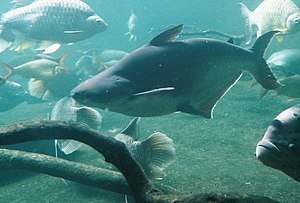Pangasianodon
| Pangasianodon | ||||||||||||
|---|---|---|---|---|---|---|---|---|---|---|---|---|

Pangasius (Pangasianodon hypophthalmus) | ||||||||||||
| Systematik | ||||||||||||
| ||||||||||||
| Wissenschaftlicher Name | ||||||||||||
| Pangasianodon | ||||||||||||
| Chevey, 1930 |
Die Gattung Pangasianodon aus der Familie der Haiwelse umfasst zwei Arten: P. hypophthalmus („Pangasius“) und P. gigas („Mekong-Riesenwels“). Beide kommen ausschließlich im Mekong und seinen Nebenflüssen vor und werden befischt, wodurch die Wildbestände bedroht sind. Während P. hypophthalmus auch einer der bedeutendsten Aquakulturfische Südostasiens ist, haben erste Versuche, P. gigas in Kultur zu nehmen, erst begonnen.[1]
Die Gattung Pangasianodon wurde aus der Gattung Pangasius aufgrund morphologischer und molekularer Unterschiede ausgegliedert, wird allerdings manchmal noch als Untergattung geführt.[1][2] Neben dem typischen Körperbau der Haiwelse mit schuppenlosem, langgestrecktem Körper, kurzer Rückenflosse mit Stachel und langer Afterflosse weist sich die Art Pangasianodon durch eine Reihe von Merkmalen aus: Die Barteln am Unterkiefer fehlen, ebenso im Erwachsenenstadium die Zähne im endständigen Maul. Die Bauchflosse trägt 8 bis 9 Strahlen und die Schwimmblase ist einlappig.[1][3]
Weblinks
Einzelnachweise
- ↑ a b c T.R. Roberts, C. Vidthayanon: Systematic revision of the Asian catfish family Pangasiidae, with biological observations and descriptions of three new species. In: Proceedings of the Academy of Natural Sciences of Philadelphia. Band 143, 1991, S. 97–144 (englisch).
- ↑ L. Pouyard, G.G. Teugels, R. Gustiano, M. Legendre: Contribution to the phylogeny of pangasiid catfishes based on allozymes and mitochondrial DNA. In: Journal of Fish Biology. Band 56, 2000, S. 1509–1538 (englisch).
- ↑ W.J. Rainboth: Fishes of the Cambodian Mekong. FAO species identification sheets for fishery purposes. Food and Agriculture Organization, Rom 1996.